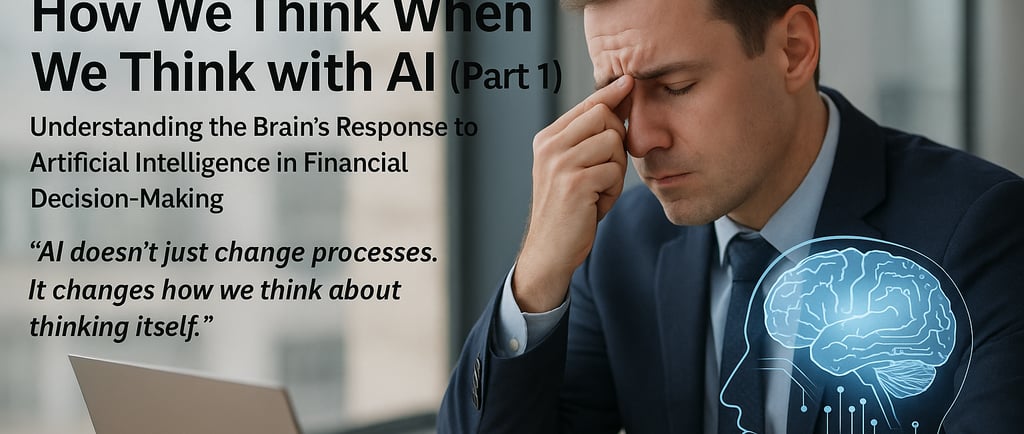NeuroFinance: How We Think When We Think with AI (Part 1)
Understanding the Brain's Response to Artificial Intelligence in Financial Decision-Making
CFO INSIGHTS
Zhivka Nedyalkova
7/10/20256 min read


Understanding the Brain's Response to Artificial Intelligence in Financial Decision-Making
"AI doesn't just change processes. It changes how we think about thinking itself."
In an era where artificial intelligence is gradually finding its place in financial management, something quieter but far more profound is happening: a transformation of human cognition. To understand why AI transformation is so challenging, let's look not at the code, but at the brain.
When AI Meets Human Intuition
Scenario: Peter, a CFO at a mid-sized company, sits in front of his monitor at 8:30 AM. The AI system recommends selling 40% of the portfolio due to "anomalous patterns in market activity." His 15 years of experience tells him otherwise. His heart races, palms sweat. This isn't just a business decision—it's a neurological conflict.
The Ancient Alarm Center in the Modern Office
When Peter reads the AI recommendation, his amygdala—two small almond-shaped structures deep in his brain—instantly interprets the situation as a threat. Neurological research shows that the amygdala is crucial for emotional processing and risk assessment in financial decisions (Bechara et al., 1999). But why does a computer recommendation trigger the same response as encountering a saber-toothed tiger?
The Evolutionary Paradox: The amygdala evolved 300 million years ago, when survival depended on split-second decisions: "Is that fruit or predator?" It's optimized for our ancestors' world—an environment where uncertainty often meant death. Today, in the boardroom, it still operates by the same logic.
When an AI system suggests something that contradicts accumulated experience, the amygdala codes it as anomaly = danger. The result? A physiological stress response: racing pulse, elevated blood pressure, sweating, foggy thinking. Peter doesn't just dislike the recommendation—his body is preparing for battle.
How to Avoid Neurological Sabotage
Strategy 1: Gradual Recalibration Instead of throwing finance professionals into the deep end with AI, successful companies use "neuronal acclimatization." They start with small, non-critical decisions where AI recommendations can be tested without dramatic consequences.
The most effective approach proves to be introducing external AI solutions that don't immediately replace internal processes but gradually complement them. These solutions work like "training wheels" for the brain—allowing employees to experiment with AI recommendations in a controlled environment without feeling threatened in their core competencies.
When external AI tools are gradually integrated into internal processes, the amygdala has time to adapt to the new technology, and the prefrontal cortex can calmly build trust in algorithmic recommendations.
Strategy 2: Transparency as Medicine When AI explains "why" it recommends a specific action, the prefrontal cortex receives information it can process rationally, calming the amygdala.
The Mystery of "Right" Decisions
Case Study: In 2008, AI systems at several major banks accurately predicted the housing market collapse. But most CFOs ignored the recommendations because they contradicted "everything we knew about the market."
When Intuition Proves Wrong
This story reveals a fundamental paradox: financial decisions are among the most important life-shaping choices people make, but due to cognitive constraints and low average levels of financial literacy, many household decisions violate sound financial principles (Frydman & Camerer, 2016). But why does this happen?
The Neurological Truth: The human brain is an incredible pattern-recognition machine, but it has a fatal flaw—preference for familiar patterns. While AI analyzes 847 different variables per second, our brain relies on 5-7 known indicators.
The Dance Between Emotion and Logic
Research reveals that the amygdala and ventromedial prefrontal cortex play different but interconnected roles: the amygdala processes emotional signals and risk, while the prefrontal cortex analyzes long-term consequences (Dal Monte et al., 2020). In healthy financial decision-making, they work like an orchestra.
But here's what happens when AI enters the game:
Step 1: AI provides a data-based recommendation
Step 2: The prefrontal cortex tries to analyze it rationally
Step 3: The amygdala "sees" conflict with familiar patterns and triggers anxiety
Step 4: Stress hormones flood the brain, disrupting communication between the two areas
Step 5: The decision is made under stress influence, not rational analysis
Why does the balance get disrupted?
The problem isn't the AI recommendation itself. The problem is that it comes from a source the brain can't "feel." For millennia, humans have made decisions based on social cues—facial expressions, tone of voice, body language. AI has none of these. To the amygdala, it's like receiving advice from a ghost.
Algorithmic Aversion: Why We Resist the Machines
Case 1: The Banker Who Doesn't Trust the Robot
Maria has managed the credit department for 12 years. The new AI system rejects applications from clients she would approve "with her eyes closed." The problem? The system analyzes 847 different variables, while Maria relies on intuition and experience.
"How can I explain to a client that I'm rejecting them because the algorithm says 'no'?"
Case 2: The Trader vs. The Forecast
Stefan has been trading currencies for 8 years. The AI model predicts a euro decline with 73% accuracy, but Stefan "feels" the market will bounce back. The dilemma: trust the data or trust the "gut feeling"?
The Science Behind Resistance
Research reveals that people often show reluctance to rely on algorithms despite their superior performance—a phenomenon known as algorithmic aversion (Mahmud et al., 2022). But why does our brain sabotage us this way?
Reason 1: The Need for Control The human brain evolved to survive through environmental control. When we delegate decisions to an algorithm, the same neural circuits activate as during loss of power or helplessness.
Reason 2: The Social Nature of Trust Trust is a social phenomenon. We believe people we have relationships with, who show empathy, who can make mistakes. AI has none of these qualities. To our brain, it's like trusting an alien.
Reason 3: Fear of Blame When Maria rejects a loan based on AI recommendation and it proves wrong, she'll bear the blame. When she approves a loan based on her intuition and it proves wrong, at least it was "human error."
The Invisible Battle in our Heads
The inner monologue of a financier in the AI era:
"The system says 'buy.' My intuition says 'sell.' The data shows one story, my experience another. Who should win? And if I'm wrong, whom do I blame?"
The Brain as Battlefield
When a financier faces an AI recommendation that contradicts their intuition, an invisible war unfolds in their head between different neural networks:
Front 1: Reward System vs. Fear System Dopamine pathways activate at the possibility of profit (AI shows potential for returns), but simultaneously the amygdala signals danger (this is unfamiliar, therefore risky).
Front 2: Automatic vs. Controlled Thinking Neuroscience distinguishes two decision-making systems: automatic (fast, intuitive) and controlled (slow, analytical). AI recommendations are processed by the controlled system, but our emotional reactions come from the automatic one.
Why the brain Interprets this as loss of control
The Neurological Explanation: When we make decisions independently, we activate networks in the prefrontal cortex associated with feelings of personal efficacy (Chang et al., 2013). When we follow AI recommendations, these networks remain inactive, and the brain interprets this as loss of agency.
The Practical Result: Even when the AI decision is objectively better, the lack of control sensation creates cognitive dissonance. The brain prefers a wrong decision it made independently over a right decision made by a machine.
How it manifests in practice:
Decreased confidence in own abilities
Increased anxiety in future decisions
Tendency to seek evidence against AI recommendations
Subconscious sabotage of algorithmic decisions
The Hormones of Fear and Greed
Real Experiment: John Coates, former Wall Street trader, measures testosterone and cortisol levels in financiers while using AI systems. The result? Chronic stress leads to worse decisions, even when AI provides accurate data.
The Chemical War in Our Bodies
Research on financial traders reveals how chronic stress affects hormonal regulation, particularly cortisol and testosterone, which directly influence risk-taking behavior (Coates & Herbert, 2008).
Cortisol - the Chronic Stress Hormone:
Normal levels: Help with focus and quick decision-making
Elevated levels: Impair memory, reduce analytical ability, increase impulsiveness
Chronically elevated: Literally "shrink" the prefrontal cortex, making rational decisions nearly impossible
Testosterone - the Risk Hormone:
High levels: Increase risk-seeking, confidence (sometimes overconfidence)
Low levels: Lead to excessive caution, missed opportunities
How AI Changes Hormonal Balance
Scenario: Imagine a trader with high cortisol levels (from stress over new technology) receiving an AI signal to buy stocks. Instead of following the recommendation, he does the opposite—because stress literally "shuts off" the rational part of his brain.
The Neurochemical Mechanism:
AI recommendation → activates stress response
Cortisol floods the brain → disrupts connection between amygdala and prefrontal cortex
Decision made emotionally → often opposite to logical choice
Result reinforces stress → creates vicious cycle
The Practical Takeaway: It's not enough to have the best AI system if users' hormonal states sabotage it. Successful financial organizations must care for their teams' neuro-hormonal hygiene.
Next week: How to train our brains to dance with algorithms instead of fighting them.
Follow FinTellect AI's blog to learn more about this neuronal odyssey in the world of finance.
